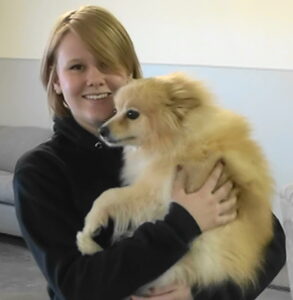Barks Blog
Using C-BARQ as an Assessment Tool
I accept behavioral cases within my dog training practice when I have the necessary education and experience to help, and I refer cases beyond my ability to other professionals. Gathering as much information about the dog in question is important to know which is which.
One tool I use is Canine Behavioral Assessment & Research Questionnaire (C-BARQ) which is “designed to provide dog owners and professionals with standardized evaluations of canine temperament and behavior.”
C-BARQ was developed by Dr. James Serpell, Professor of Animal Welfare at the University of Pennsylvania, in the United States. It is widely used by trainers and behavior professionals and organizations such as Guiding Eyes for the Blind.
It is designed as a dog owner survey with 101 questions and measures ways in which dogs typically respond to common events and situations in their environment.
The survey may be downloaded here.
In a review of commonly used behavior assessment tools Dr. Jessica Hekman wrote an article comparing SAFER (1) and Assess-A-Pet (2) findings with C-BARQ , citing several studies. My understanding of this article is that C-BARQ is more reliable in identifying canine aggression.
Deborah L. Duffy and James A. Serpell reported in Applied Animal Behaviour Science that C-BARQ was “able to discriminate between dogs that are behaviorally suited for guide or service work…and may provide trainers with useful information about potential training or breeding candidates as early as 6 months of age.”
I confess I took this quote from the abstract. My goal is not to convince anyone they should use one tool or another, only to explain that I consider C-BARQ useful. You may prefer other tools.
In my experience there is an Achilles heel when using a survey completed by dog owners to report anxiety, fear and aggression in their pets. Many pet owners are not very good at recognizing those behaviors.

In a study by Michelle Wan, Nicall Bolger and Frances A. Champagne the researchers reported “more than 60% of dog owners perceive these emotions in their dogs: anger, fear, happiness, sadness.” That makes me think nearly 40% are not perceiving those emotions.
They also noted “experience was a significant predictor of the number of features that participants selected for both happy and fearful emotional examples.”
Linda P. Case discussed two studies in her blog “Fear Itself” on The Science Dog website, relative to the accuracy of our perceptions of dog’s emotional states. One study was conducted by researchers in the Department of Psychology at Columbia University using video clips in an online survey. The other study was conducted at the University of Pisa in Italy in which dog owners were asked about stress in dogs.
Case summarized that perceptions of fear strongly correlated to their prior experience with dogs, and pet owners paid less attention to facial expressions and eyes when looking for signs of stress.
My recent experience with a new client illustrated that I could not rely too heavily upon an owner survey. The family asked for help with their dogs, Rexi and Grayson (3). They reported Rexi had a problem with dog-dog reactivity during neighborhood walks, and barked when left behind at the camper when the family took trips. For that they had used a bark collar. Grayson, on the other hand, was reported as having no problems other than sometimes being bothered by Rexi’s behavior.
I collected information with C-BARQ and email conversations and wrote a training and behavior plan, including a Project Trade offer. Confident in my preparation I approached the front door of their home and knocked softly.
Fierce barking erupted from the living room as abruptly as Mount St. Helens blowing it’s top, and Grayson came rushing to the door with the speed of a pyroclastic eruption. He launched himself against the window pane as if to show me his dilated pupils and repeatedly slammed against the door as he growled his toothy greeting.
Needless to say I paid attention to his eyes and facial expressions.

Rexi trotted to the door with curiosity, but no drama.
The parents stood passively and took no action to remove Grayson, while their two children giggled in amusement.
Upon my request they secured Grayson in a room and I entered, beginning a two-hour discussion of canine arousal and aggression, using graphic illustrations, and adjusted the training and behavior plan. Rexi settled comfortably by my side and I engaged in some training exercises, involving family members.
The wife turned to the husband and remarked “It is clear now that Grayson has a behavior problem.” They had grown accustomed to Grayson’s greeting behavior and felt falsely secure “because he settles down after a few minutes…and he never tries to bite anyone.” They had come to see unstable behavior as the norm.
I empathized with them and remembered when I failed to recognize or understand canine body language. If pet owners do not recognize signs of anxiety, fear or aggression then we may not expect them to report such behaviors in a survey.
C-BARQ will continue to be one of the tools I use, but I will not rely too heavily upon dog owners to accurately report behaviors.
References:
Hekman, Jessica, DVM, MS, The BARK Dog Is My Co-Pilot©, Testing Behavior Tests, pages 1-4. https://thebark.com/content/testing-behavior-tests.
Duffy, Deborah L. & Serpell, James A. (2012, April) Predictive validity of a method for evaluating temperament in young guide and service dogs, Applied Animal Behaviour Science, Volume 138, Issued 1-2, Pages 99-109.
Michelle Wan, Nicall Bolger, Frances A. Champagne. (2012) Human Perception of Fear in Dogs Varies According to Experience with Dogs. PLoS ONE 7(12): e51775. doi:10.1371/journal.pone.0051775.
(1) Developed by Emily Weiss, PhD, of the ASPCA
(2) Developed by Sue Sternberg of Rondout Valley Animals for Adoption
(3) Fictitious names, to protect client confidentiality
Daniel H. Antolec, PCT-A, CPDT-KA is the owner of Happy Buddha Dog Training. He has membership in Pet Professional Guild and is Chairman of Advocacy Committee. As a member of Dogs on Call, Inc. his Labradors Buddha and Gandhi are registered Pet Partners therapy dogs.

